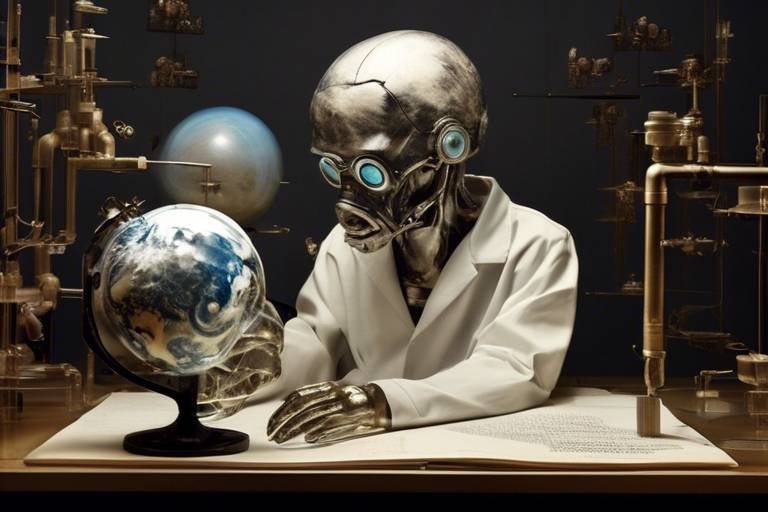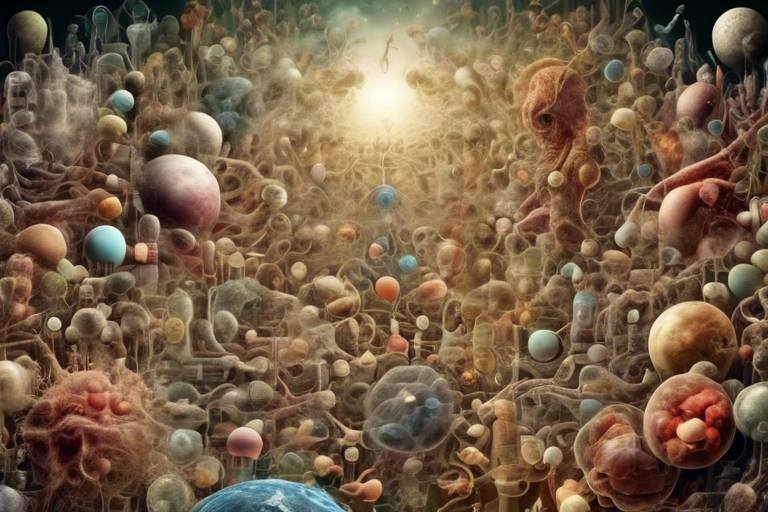Are Scientific Theories Influenced by Human Biases?
When we think about science, we often picture a realm of cold, hard facts, where theories are built on objective evidence and logical reasoning. However, the reality is far more nuanced. Scientific theories are not just the products of rigorous experimentation; they are also shaped by the very human beings who create them. This raises a crucial question: The answer is a resounding yes. Cognitive, cultural, and social factors all play a significant role in how scientific knowledge is developed and accepted. Understanding these influences can provide us with a clearer picture of the scientific process and its complexities.
Consider this: when a scientist embarks on a research project, they bring with them a lifetime of experiences, beliefs, and values. These elements can subtly, yet profoundly, influence their hypotheses, methods, and interpretations of results. For instance, a researcher might unconsciously design experiments that favor their preconceived notions, leading to a skewed representation of the data. This interplay between human biases and scientific inquiry is not just a minor flaw; it is a fundamental aspect of how science operates. By acknowledging these biases, we can better understand the evolution of scientific theories and the potential for error inherent in the process.
Moreover, the implications of human biases extend beyond individual research projects. They can shape entire fields of study, influencing what questions are asked, what methodologies are deemed acceptable, and which theories gain traction within the scientific community. This can create a ripple effect, where certain ideas are perpetuated while others are marginalized, not necessarily due to their scientific merit, but because of the biases of those in power. This dynamic is particularly evident in the historical context of scientific development, where societal norms and cultural values have often dictated what is considered 'valid' science.
In the following sections, we will delve deeper into the various types of biases that can influence scientific theories, including cognitive biases such as confirmation bias and the availability heuristic. We will also explore how cultural contexts and social dynamics contribute to the shaping of scientific knowledge. By doing so, we aim to illuminate the intricate web of factors that govern scientific inquiry and the development of theories, ultimately revealing the human side of science.
- What are cognitive biases? Cognitive biases are systematic patterns of deviation from norm or rationality in judgment, which can affect the decisions and judgments that people make.
- How do cultural factors influence science? Cultural factors influence science by shaping the questions that are asked, the methods that are used, and the interpretations of data based on societal beliefs and values.
- Can biases in science be eliminated? While biases can be mitigated through rigorous methodologies and peer review, it is unlikely that they can be completely eliminated due to the inherent nature of human cognition.

The Nature of Scientific Theories
Understanding what constitutes a scientific theory is crucial for anyone delving into the world of science. At its core, a scientific theory is not just a guess or a hypothesis; it is a well-substantiated explanation of some aspect of the natural world that is based on a body of evidence. This evidence is gathered through observation, experimentation, and reasoning. In essence, scientific theories serve as the frameworks through which we interpret the complexities of the universe.
One of the defining characteristics of a scientific theory is its ability to be tested and falsified. This means that a theory must make predictions that can be observed and measured. If new evidence contradicts the theory, it must be revised or discarded altogether. This dynamic nature of scientific theories is what makes science a constantly evolving discipline. Consider the theory of evolution; it has undergone numerous modifications as new evidence has emerged, yet it remains a cornerstone of biological sciences.
Moreover, scientific theories are not isolated constructs; they often interlink with one another, forming a complex web of knowledge. For instance, the theory of gravity is intertwined with theories in physics and astronomy, influencing our understanding of everything from falling apples to the orbits of planets. This interconnectedness highlights the collaborative nature of scientific inquiry, where theories build upon one another, enhancing our comprehension of the world.
In addition to their interrelatedness, scientific theories also serve several important purposes:
- Explanatory Power: They provide coherent explanations for observable phenomena.
- Predictive Capability: Theories allow scientists to make predictions about future events or observations.
- Guidance for Research: They help direct scientific inquiry and experimentation, suggesting new avenues for investigation.
To further illustrate the nature of scientific theories, let's take a look at the following table that summarizes their key features:
| Feature | Description |
|---|---|
| Testability | Theories must be testable through experiments and observations. |
| Falsifiability | Theories must be able to be proven false if new evidence contradicts them. |
| Consistency | Theories should be consistent with existing knowledge and observations. |
| Scope | Theories should apply broadly to a range of phenomena, not just isolated cases. |
In conclusion, scientific theories are the backbone of scientific understanding. They are not static; rather, they are living entities that evolve with new discoveries and insights. By recognizing the nature of these theories, we can better appreciate the intricate dance between observation, experimentation, and the ever-changing landscape of scientific knowledge.

Cognitive Biases in Science
Cognitive biases are like the invisible glasses through which scientists view their research and the world around them. These biases can significantly affect scientific reasoning and the validity of the conclusions drawn from various studies. Imagine trying to navigate through a foggy landscape; your perception of the path ahead is distorted by the haze, making it difficult to see the truth. In the world of science, cognitive biases can lead to similar distortions, affecting the way theories are formed and accepted. They can skew data interpretation, influence research design, and ultimately impact the scientific knowledge that we rely on.
One of the most prevalent cognitive biases in scientific inquiry is confirmation bias. This bias occurs when scientists favor information that supports their pre-existing beliefs or hypotheses while dismissing evidence that contradicts them. It’s akin to only reading headlines that confirm your opinion while ignoring articles that present a different viewpoint. This selective attention can lead to a skewed understanding of research findings and can have profound implications on the development of scientific theories. For instance, if a researcher believes in a particular theory, they may unconsciously design experiments that are more likely to yield results supporting that theory, thereby reinforcing their initial belief.
Another significant cognitive bias is the availability heuristic. This bias affects how scientists perceive evidence based on how easily examples come to mind. If a scientist has recently read about a specific phenomenon, they might overestimate its prevalence or significance simply because it’s fresh in their memory. This can lead to an overemphasis on certain theories while neglecting others that may be equally or more important. The availability heuristic can create a ripple effect, influencing not only individual research but also the broader scientific community’s understanding of a topic.
To illustrate the impact of these cognitive biases on scientific research, consider the following table that summarizes key biases and their implications:
| Bias | Description | Implications for Science |
|---|---|---|
| Confirmation Bias | The tendency to favor information that confirms existing beliefs. | Can lead to flawed research outcomes and reinforce incorrect theories. |
| Availability Heuristic | The tendency to judge the frequency or likelihood of an event based on how easily examples come to mind. | Can cause misjudgment of the importance of certain theories or phenomena. |
Recognizing these biases is the first step towards mitigating their effects. Researchers can implement strategies such as blind analysis, where the data is analyzed without knowledge of the hypothesis, or peer review processes that encourage diverse perspectives. By fostering an environment that values skepticism and open-mindedness, the scientific community can work towards minimizing the influence of cognitive biases on theory development and acceptance.
In conclusion, cognitive biases are an inherent part of human thinking that can significantly influence scientific inquiry. By understanding and addressing these biases, scientists can strive for a more objective and accurate representation of the natural world, ultimately leading to a richer and more reliable body of scientific knowledge.

Confirmation bias is one of those sneaky little culprits that can really mess with scientific reasoning. Imagine a scientist who has a pet theory about how a certain drug can cure a disease. Instead of looking at all the evidence objectively, they might focus only on the studies that support their belief and conveniently ignore those that contradict it. This is confirmation bias in action, and it can lead to some pretty skewed interpretations of data. When scientists allow their preconceived notions to cloud their judgment, they risk distorting research outcomes. This phenomenon is not just a personal flaw; it’s a systemic issue that can influence the entire scientific community.
To illustrate, let’s consider a few key points about confirmation bias:
- Selective Attention: Researchers may pay more attention to evidence that confirms their hypotheses while dismissing or undervaluing contradictory evidence.
- Research Design: When designing experiments, scientists might unconsciously create conditions that favor their expected outcomes, leading to biased results.
- Publication Bias: Studies that confirm popular theories are more likely to be published than those that challenge them, creating a skewed body of literature.
The implications of confirmation bias are profound. It not only affects individual research but can also influence the broader scientific discourse. When certain theories gain traction due to confirmation bias, they can overshadow alternative explanations, limiting the scope of inquiry. This can create a ripple effect, where subsequent research builds upon flawed foundations, leading to a cascade of errors that can persist for years. The scientific method, ideally a self-correcting process, can become bogged down by these biases if not carefully monitored.
Moreover, confirmation bias can also impact peer review and the acceptance of new theories. When reviewers have their own biases, they may favor papers that align with their beliefs, further entrenching existing theories and making it difficult for groundbreaking ideas to gain traction. This creates an echo chamber effect, where only certain viewpoints are heard and validated, stifling innovation and progress within the scientific community.
So, how can researchers combat confirmation bias? Here are a few strategies:
- Encourage Diverse Perspectives: Collaborating with scientists from different backgrounds can help challenge prevailing assumptions.
- Blind Studies: Implementing blinding techniques in experiments can reduce bias in data collection and interpretation.
- Critical Self-Reflection: Researchers should regularly question their own assumptions and seek out evidence that contradicts their beliefs.
In conclusion, confirmation bias is a critical factor that can distort scientific inquiry and theory formation. By recognizing its presence and actively working to mitigate its effects, scientists can strive for a more objective and comprehensive understanding of the natural world. The journey toward scientific knowledge is not just about discovering truths; it's also about overcoming the biases that can lead us astray.

When we talk about the impacts of confirmation bias on research design, it's like looking through a distorted lens. Researchers, often unwittingly, may design their experiments in a way that leans towards their preconceived notions. This bias can lead to a series of consequences that can ripple through the entirety of scientific inquiry. For instance, when a scientist is convinced of a particular outcome, they might select methods or data that support this belief while neglecting those that might contradict it. This selective approach can skew results, leading to findings that do not accurately represent reality.
One of the most critical aspects of research design that can be affected by confirmation bias is the selection of variables. Researchers might unconsciously prioritize certain variables that affirm their hypothesis while ignoring others that could provide a more balanced view. This can create a situation where the research is not only flawed but also fails to contribute meaningfully to the broader scientific dialogue.
To illustrate this point, consider the following table that outlines common research design flaws influenced by confirmation bias:
| Flaw | Description | Potential Consequences |
|---|---|---|
| Selective Reporting | Only reporting results that support the hypothesis | Misleading conclusions that cannot be replicated |
| Cherry-Picking Data | Choosing data points that confirm existing beliefs | Inaccurate representation of the overall dataset |
| Confirmation of Hypotheses | Designing studies to confirm rather than test hypotheses | Stagnation in scientific progress and innovation |
Moreover, researchers can mitigate the effects of confirmation bias by employing strategies such as blind studies or involving collaborators from diverse backgrounds to challenge existing assumptions. By doing so, they can foster an environment that encourages critical thinking and open dialogue, which are essential for robust scientific inquiry. Incorporating peer feedback and conducting pre-registrations of studies also help in keeping biases at bay.
Ultimately, the design of research is not just about following a formula; it’s about ensuring that the quest for knowledge remains untainted by personal biases. When scientists commit to rigorous methodologies and embrace a culture of skepticism, they pave the way for discoveries that are not only innovative but also grounded in reality. After all, science thrives on questioning and refining ideas, not merely confirming them.

To truly understand the impact of confirmation bias on scientific research, we can look at several compelling case studies that illustrate how these biases have shaped theories and outcomes. One notable example is the work surrounding the theory of cold fusion, which emerged in 1989 when chemists Martin Fleischmann and Stanley Pons claimed to have achieved nuclear fusion at room temperature. Their announcement sparked excitement and skepticism in equal measure. However, as more scientists attempted to replicate their findings, it became clear that many were influenced by their own biases, favoring results that aligned with the initial claims while overlooking contradictory evidence. This case highlights how confirmation bias can lead to a distorted view of scientific validity, ultimately affecting the trajectory of research.
Another illustrative case is the ongoing debate surrounding the link between vaccines and autism. Despite overwhelming evidence disproving this connection, some researchers and the public continue to cling to the idea, often due to confirmation bias. They selectively interpret data and focus on studies that support their beliefs, while dismissing a vast body of research that contradicts these claims. This persistent bias not only hinders scientific progress but also poses significant public health risks.
Furthermore, the case of climate change denial offers a stark illustration of how confirmation bias operates within scientific discourse. Some scientists and policymakers have shown a tendency to favor data that downplays human impact on climate change, often ignoring extensive evidence that supports the opposite view. This bias can lead to flawed policy decisions and a lack of action on critical environmental issues. The implications of these biases extend beyond the laboratory, affecting societal perceptions and actions regarding pressing global challenges.
These case studies reveal a common thread: the tendency for scientists to allow their preconceptions to influence their research outcomes. To combat this, researchers must adopt rigorous methodologies and remain vigilant against their biases. By fostering a culture of critical thinking and encouraging open dialogue, the scientific community can work towards minimizing the impact of confirmation bias on research.
In summary, understanding how confirmation bias operates within scientific research is crucial for the advancement of knowledge. By examining these case studies, we can better appreciate the need for transparency and objectivity in scientific inquiry. Only then can we ensure that science remains a reliable tool for understanding the world around us.
- What is confirmation bias?
Confirmation bias is the tendency to favor information that confirms one’s existing beliefs while disregarding evidence that contradicts them.
- How does confirmation bias affect scientific research?
It can lead to flawed methodologies, distorted research outcomes, and the acceptance of theories that lack robust evidence.
- What can be done to mitigate confirmation bias?
Researchers can adopt rigorous methodologies, encourage peer review, and foster a culture of critical thinking to minimize biases in their work.
- Are there other biases that affect scientific inquiry?
Yes, other biases such as the availability heuristic and cultural biases can also influence how scientists interpret data and develop theories.

The availability heuristic is a fascinating cognitive shortcut that influences how scientists and researchers assess evidence and make decisions. Essentially, it's the mental process where individuals rely on immediate examples that come to mind when evaluating a specific topic or decision. This can lead to a skewed perception of reality, particularly in the realm of scientific inquiry. For instance, if a scientist recently read about a rare disease, they might overestimate its prevalence simply because that information is more readily available in their memory. This phenomenon is not just a quirk of human psychology; it can have profound implications for the development and acceptance of scientific theories.
To illustrate how the availability heuristic operates, consider the following scenarios:
- A researcher might focus on recent studies that confirm their hypothesis while ignoring older data that contradicts it.
- Public perception of climate change can be heavily influenced by recent weather events, leading to an exaggerated belief in its immediacy or severity.
- In medicine, doctors might diagnose conditions based on the most recent cases they've encountered, potentially overlooking rarer but more relevant diagnoses.
This reliance on readily available information can create a feedback loop where certain theories gain traction purely because they are frequently discussed or highlighted in literature, rather than because they are rigorously supported by evidence. As a result, the scientific community may inadvertently prioritize certain lines of inquiry over others, leading to a narrow view of what constitutes valid scientific knowledge.
Moreover, the availability heuristic can contribute to the phenomenon known as groupthink, where scientists working within a collaborative environment may collectively overlook alternative theories or data that do not align with the prevailing narrative. This can stifle innovation and lead to stagnation in scientific progress. To counteract these effects, researchers need to actively seek out diverse sources of information and remain vigilant about questioning their own assumptions.
In sum, the availability heuristic serves as a double-edged sword in scientific research. While it can facilitate quick decision-making and hypothesis generation, it also risks distorting the understanding of evidence and the acceptance of scientific theories. Recognizing this bias is the first step in mitigating its impact, allowing for a more balanced and comprehensive approach to scientific inquiry.

When we think about science, we often imagine a realm of cold, hard facts and objective truths. However, the reality is much more nuanced and complex. Cultural contexts play a profound role in shaping scientific theories and the way we interpret the world around us. Just like a painter uses different colors to create a masterpiece, scientists are influenced by the cultural palette of their time, which can significantly affect their research and conclusions.
To understand this influence, we must first acknowledge that science does not exist in a vacuum. It is a human endeavor, deeply intertwined with the values, beliefs, and practices of the society in which it is conducted. For instance, consider how cultural beliefs about health can shape medical research. In cultures that prioritize holistic approaches, scientific inquiries may lean towards alternative medicine, while in others, they may strictly adhere to conventional medical practices. This divergence can lead to varying acceptance levels of different scientific theories across cultures.
One fascinating aspect of cultural influence is the concept of scientific paradigms. Philosopher Thomas Kuhn introduced this idea to explain how dominant scientific theories can shift dramatically when new cultural ideas emerge. For example, the transition from Newtonian physics to Einstein's theory of relativity didn't just stem from mathematical advancements; it was also a cultural revolution that challenged the way people perceived time and space. These shifts often reflect broader societal changes, illustrating how science evolves alongside culture.
Moreover, the acceptance of scientific theories can vary widely across different cultures. For instance, the theory of evolution is widely accepted in many Western societies, yet it faces significant resistance in some religious communities. This discrepancy highlights how cultural beliefs can either bolster or hinder the acceptance of scientific ideas. Understanding these dynamics is crucial for scientists and educators who aim to communicate scientific knowledge effectively. They must navigate the cultural landscape to foster understanding and acceptance of scientific theories.
Exploring scientific theories through a cross-cultural lens can enrich our understanding of science itself. Different cultures approach scientific inquiry in unique ways, often leading to innovative perspectives and breakthroughs. For example, indigenous knowledge systems offer valuable insights into ecological science, emphasizing the importance of sustainability and harmony with nature. By integrating these diverse viewpoints, we can create a more holistic understanding of scientific concepts.
In summary, cultural influences on scientific theories are profound and multifaceted. They shape not only the development of scientific ideas but also their acceptance and application in society. By recognizing and embracing these cultural dimensions, we can enhance our scientific discourse and foster a more inclusive approach to knowledge creation.
- How do cultural beliefs impact scientific research? Cultural beliefs can influence the questions scientists choose to explore, the methods they use, and the interpretations they make.
- What is a scientific paradigm? A scientific paradigm is a set of practices and beliefs that define a scientific discipline at any particular period of time, shaping how research is conducted and theories are accepted.
- Can different cultures have conflicting scientific theories? Yes, different cultures can develop conflicting scientific theories based on their unique beliefs, values, and experiences, leading to varying acceptance of certain ideas.

When we think about scientific paradigms, it’s essential to recognize that they are not just abstract concepts; they are the very frameworks that shape how scientists understand the world. Thomas Kuhn, in his groundbreaking work "The Structure of Scientific Revolutions," introduced the idea of paradigms as the set of practices that define a scientific discipline at any particular period of time. These paradigms dictate what is considered valid research, what questions are worth asking, and even how data is interpreted. In essence, they serve as the lenses through which scientists view their work and the universe.
Imagine a pair of sunglasses: when you put them on, the world looks different. Similarly, a scientific paradigm colors the way researchers perceive their findings and the phenomena they study. For instance, during the Newtonian paradigm, the universe was viewed as a vast machine, predictable and governed by strict laws. However, with the advent of the Einsteinian paradigm, this mechanistic view was challenged, leading to revolutionary concepts like relativity and quantum mechanics. This shift did not just change individual theories; it transformed the entire landscape of physics.
Moreover, paradigms are not static; they evolve over time. As new discoveries are made and as societal values shift, existing paradigms may come under scrutiny. This is where the concept of scientific revolutions comes into play. A scientific revolution occurs when the prevailing paradigm is replaced by a new one, often after a period of intense debate and resistance. This transformation is not merely a change in theory; it can lead to a complete overhaul of how science is conducted. For example, the transition from classical physics to quantum physics was not just a minor adjustment; it was a paradigm shift that redefined our understanding of matter and energy.
To illustrate the impact of scientific paradigms, consider the following table, which highlights key historical shifts in scientific thought:
| Paradigm Shift | Old Paradigm | New Paradigm | Key Figure | Year |
|---|---|---|---|---|
| Copernican Revolution | Geocentrism | Heliocentrism | Nicolaus Copernicus | 1543 |
| Newtonian Revolution | Aristotelian physics | Newtonian mechanics | Isaac Newton | 1687 |
| Einstein's Theory of Relativity | Newtonian physics | Relativity | Albert Einstein | 1905 |
| Quantum Mechanics | Classical physics | Quantum theory | Max Planck | 1900 |
As we can see, each paradigm shift has not only redefined scientific understanding but also influenced the broader cultural context. The acceptance of new paradigms often requires a shift in public perception and can be met with significant resistance from the scientific community. This resistance is typically rooted in the comfort of established norms and the fear of the unknown. However, as new evidence emerges and as societal needs evolve, the acceptance of new paradigms becomes essential for scientific progress.
In conclusion, understanding scientific paradigms is crucial for grasping how scientific knowledge evolves. They shape our inquiries, influence our interpretations, and ultimately guide the trajectory of scientific discovery. As we navigate the complexities of modern science, recognizing the impact of these paradigms allows us to appreciate the dynamic nature of knowledge and the ever-changing landscape of human understanding.

When we dive into the world of science, it's easy to think of it as a universal language, a set of truths that apply to everyone, everywhere. However, the reality is much more complex. Cultural contexts play a crucial role in shaping scientific theories and practices. Different cultures bring unique beliefs, values, and historical backgrounds that can influence how scientific inquiry is approached and understood.
For instance, consider how indigenous knowledge systems often incorporate holistic views of nature, contrasting sharply with the reductionist approaches typically favored in Western science. This divergence leads to different methodologies and interpretations of scientific phenomena. In many indigenous cultures, the relationship between humans and nature is seen as interconnected, fostering a sense of stewardship rather than exploitation. This perspective not only impacts environmental science but also contributes to sustainability practices that are increasingly vital in today’s world.
Moreover, the acceptance of scientific theories can vary significantly across cultures. In some societies, traditional beliefs may conflict with scientific explanations, leading to skepticism or outright rejection of certain scientific concepts. For example, the theory of evolution is widely accepted in many parts of the world, yet it faces resistance in others due to religious or cultural beliefs. This illustrates how cultural beliefs can shape the landscape of scientific acceptance and understanding.
Additionally, cross-cultural perspectives can enrich scientific discourse. By engaging with diverse cultural viewpoints, scientists can uncover new questions and methodologies that may not have been considered in a more homogeneous context. This interaction can lead to innovative solutions to global challenges, as different cultures contribute their unique insights and experiences.
To illustrate this further, let's take a look at how various cultures approach a common scientific challenge: environmental conservation. Below is a table summarizing different cultural approaches:
| Cultural Perspective | Approach to Conservation | Key Beliefs |
|---|---|---|
| Western Science | Data-driven, empirical research | Nature as a resource for human use |
| Indigenous Cultures | Holistic stewardship | Interconnectedness of all living things |
| Eastern Philosophies | Balance and harmony with nature | Humans as part of the natural order |
As seen in the table, the differences in approaches highlight how cultural contexts can lead to diverse methodologies and priorities in scientific research. By embracing these cross-cultural perspectives, we can foster a more inclusive scientific community that values multiple viewpoints and encourages collaboration.
In conclusion, understanding scientific theories through cross-cultural lenses not only broadens our comprehension of science but also enhances its relevance in a globalized world. By recognizing and integrating various cultural insights, we can create a richer, more nuanced understanding of scientific phenomena, ultimately leading to better solutions for the challenges we face today.
- How do cultural biases affect scientific research?
Cultural biases can shape the questions scientists ask, the methods they use, and how they interpret their findings, potentially leading to skewed results. - Can indigenous knowledge contribute to modern science?
Absolutely! Indigenous knowledge offers valuable insights, particularly in areas like environmental management and sustainability, which can complement scientific research. - What is confirmation bias?
Confirmation bias is the tendency to favor information that confirms one's existing beliefs, which can distort scientific inquiry and theory formation. - Why is it important to consider cross-cultural perspectives in science?
Considering cross-cultural perspectives fosters innovation, enriches scientific understanding, and helps address global challenges more effectively.

When we think about science, we often picture solitary figures in lab coats, hunched over their experiments, deep in thought. However, the reality is far more complex and vibrant. Social dynamics play a crucial role in shaping scientific theories and guiding the direction of research. Scientists are not just isolated thinkers; they are part of a larger community that influences their work, ideas, and even the acceptance of their findings. The interplay between collaboration and competition among scientists can significantly impact which theories gain traction and which ideas are left on the cutting room floor.
One of the most fascinating aspects of social dynamics in science is how collaboration can lead to groundbreaking discoveries. When researchers come together, they bring diverse perspectives and expertise that can challenge existing beliefs and foster innovation. For example, consider the collaborative efforts in the Human Genome Project, where scientists from around the world worked together to map the entire human genome. This monumental task not only advanced our understanding of genetics but also set the stage for future medical breakthroughs. The synergy created by diverse teams can result in a kind of intellectual explosion, where the whole becomes greater than the sum of its parts.
On the flip side, competition among scientists can also drive progress. The race to publish findings or secure funding can create an environment where only the most compelling theories rise to the surface. This competitive nature can lead to significant advancements, but it can also result in a pressure cooker atmosphere that may stifle creativity. Researchers may feel compelled to conform to popular theories or methodologies, fearing that their unique ideas might not be well-received. This dynamic can create an echo chamber where prevailing theories are continually reinforced, making it challenging for new ideas to break through.
Moreover, social dynamics extend beyond just the relationships between scientists. The broader scientific community, including institutions, funding agencies, and even the public, can influence which theories are accepted. For instance, funding bodies often prioritize research that aligns with current societal needs or trends. This can lead to a situation where certain areas of research receive disproportionate attention, while others languish in obscurity. The tug-of-war between funding priorities and scientific curiosity can shape the landscape of scientific inquiry.
Another critical aspect of social dynamics in science is the role of peer review. This process, while essential for maintaining scientific rigor, can also be influenced by social factors. Reviewers may have biases based on their own experiences, affiliations, or even personal relationships. This can lead to inconsistencies in how theories are evaluated and accepted. The outcome of peer review can significantly impact a scientist's career, influencing their future research opportunities and collaborations.
In summary, the social dynamics surrounding scientific inquiry are as important as the scientific methods employed. The interplay of collaboration and competition, combined with the influence of funding and peer review, creates a complex web that shapes the development and acceptance of scientific theories. Understanding these dynamics is essential for grasping how knowledge is constructed and accepted in the scientific community.
- How do social dynamics affect scientific research?
Social dynamics influence research through collaboration, competition, and the impact of funding and peer review, shaping which theories gain acceptance. - Can competition among scientists hinder innovation?
While competition can drive progress, it may also create pressure to conform, potentially stifling unique ideas and creativity. - What role does peer review play in shaping scientific theories?
Peer review maintains scientific rigor but can also be influenced by biases, affecting the acceptance of theories and research findings.
Frequently Asked Questions
- What are scientific theories and how are they defined?
Scientific theories are well-substantiated explanations of some aspect of the natural world. They are based on a body of evidence and are designed to explain phenomena through observation, experimentation, and reasoning. Theories evolve over time as new evidence emerges, making them dynamic rather than static.
- How do cognitive biases affect scientific research?
Cognitive biases, such as confirmation bias and the availability heuristic, can greatly influence scientific reasoning. These biases may lead researchers to favor information that supports their preexisting beliefs or to misjudge the importance of evidence based on how readily it comes to mind. This can distort research outcomes and hinder the development of objective scientific theories.
- What is confirmation bias and why is it significant?
Confirmation bias is the tendency to search for, interpret, and remember information in a way that confirms one’s existing beliefs. This bias is significant because it can skew research design and outcomes, leading to flawed methodologies and potentially incorrect conclusions in scientific inquiry.
- Can you provide examples of confirmation bias in scientific research?
Yes! One notable example is the case of the early research on vaccines and autism. Many studies that suggested a link were favored, while those disproving it were often ignored, which led to widespread misconceptions and public fear. Such examples highlight how biases can shape scientific narratives.
- What is the availability heuristic and how does it impact science?
The availability heuristic is a mental shortcut that relies on immediate examples that come to mind when evaluating a specific topic or decision. In science, this can lead to an overemphasis on recent or memorable studies, potentially skewing perceptions of evidence and affecting the acceptance of new theories.
- How do cultural factors influence scientific theories?
Cultural factors can shape scientific theories by influencing the questions scientists ask, the methods they use, and how they interpret results. Different cultures may prioritize different aspects of inquiry, leading to diverse scientific perspectives and approaches that enrich the overall understanding of scientific phenomena.
- What are scientific paradigms and how do they relate to cultural influences?
Scientific paradigms are frameworks of understanding that dictate how science is conducted within a particular culture. According to Thomas Kuhn, shifts in these paradigms can lead to scientific revolutions, as new ideas challenge established norms and lead to the acceptance of new theories.
- How do social dynamics affect scientific theories?
Social dynamics play a crucial role in shaping scientific theories through collaboration and competition among scientists. These interactions can influence research priorities, funding availability, and the acceptance of new ideas, ultimately impacting the development and evolution of scientific knowledge.



















